Reports
The Plan: Iran’s Nuclear Archive Shows it Planned to Build Five Nuclear Weapons by mid-2003
by David Albright, Olli Heinonen*, and Andrea Stricker
November 20, 2018
For a summary of this report, click here.
New findings from the Nuclear Archive:
- Plan to manufacture five nuclear warheads at 10 kilotons each
- Endeavor to be prepared to carry out an underground nuclear test
- Attempt to acquire highly enriched uranium (HEU) from abroad
- Start of building of parallel fuel cycle to produce HEU for nuclear weapons
- Fordow enrichment plant was designed to produce HEU
- Supreme Council for Advanced Technologies was overseeing these efforts
How many nuclear weapons did Iran plan to make and how was it going to implement this decision? This question was not answerable in late 2015 and early 2016, based on the information in the hands of the International Atomic Energy Agency (IAEA), when the long outstanding issues, including the Possible Military Dimensions (PMD), were addressed before the start of the implementation of the Joint Comprehensive Plan of Action (JCPOA). But now, with Israel’s 2018 seizure of documents, computer files, and images from a “Nuclear Archive” in Tehran, such questions can be far better addressed.
This report discusses a slide from a fairly long Iranian presentation, dated to the late 1990s or early 2000, which states that Iran intended to build five nuclear warheads, each with an explosive yield of 10 kilotons and able to be delivered by ballistic missile (Figure 1).2 This report discusses another document available from the archive that provides an early look at how Iran planned to achieve its goal of designing and manufacturing five nuclear weapons and by about 2003 (Figures 2-4).
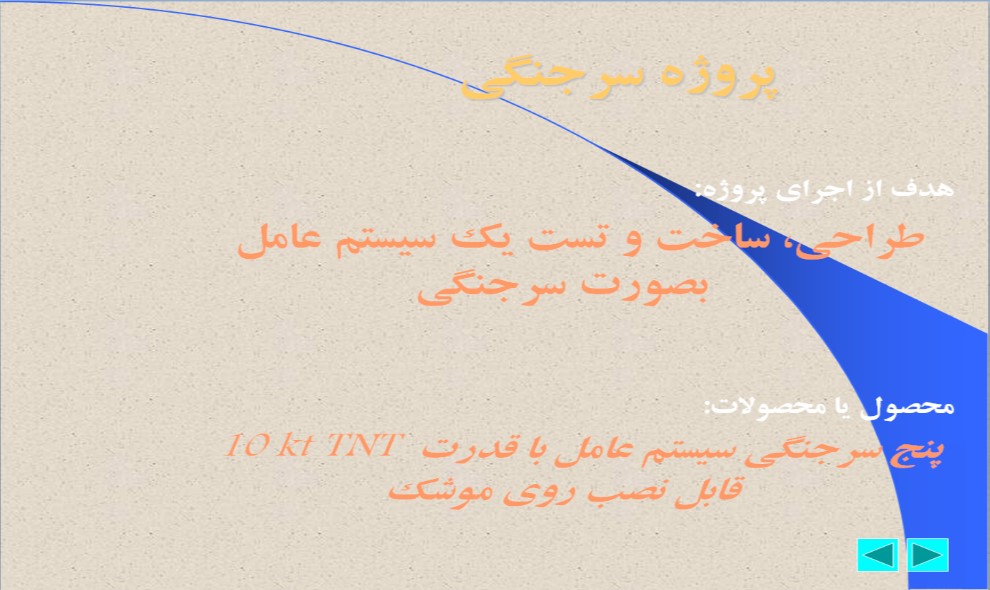
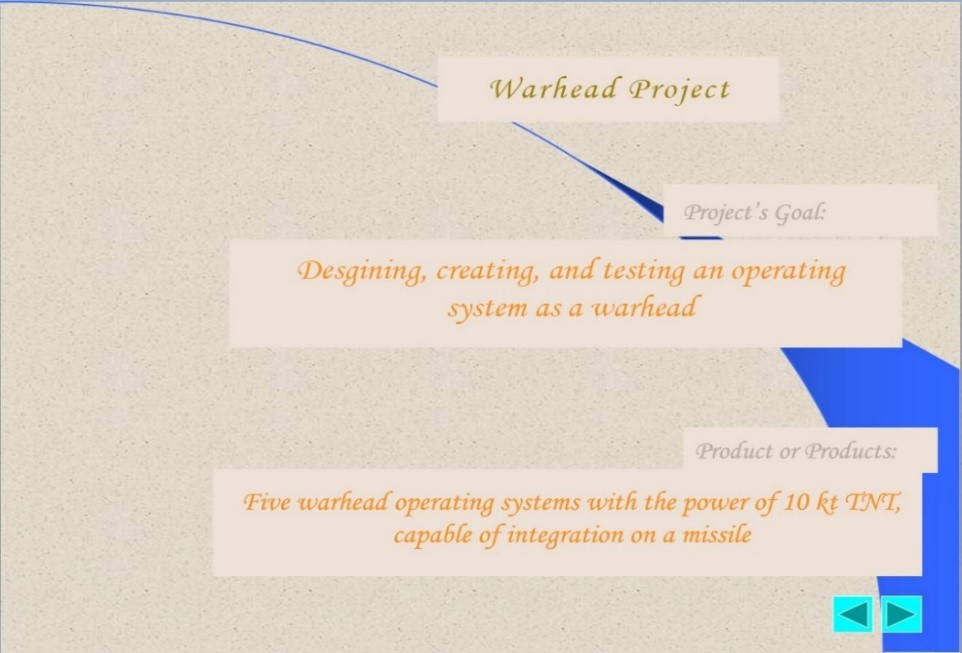
Figure 1. Warhead Project slide from the Iranian archive presented in Prime Minister Netanyahu’s April 30th presentation (in Farsi (above) and in English translation (below)). Thanks to Behnam Ben Taleblu and a professional translator for assistance.
These documents show, in addition to other documents assessed by the Institute3, that Iran had put in place by the end of 2003 the infrastructure for a comprehensive nuclear weapons program. The evidence supports that Iran was preparing to conduct an underground test of a nuclear weapon, if necessary. The end goal was to have tested, deliverable nuclear weapons, and Iran made more progress toward that goal than known before the seizure of the archives.
Today, the IAEA has access to much, if not most, of the content of the Iranian archives seized by Israel in Tehran. Although the onus remains on Iran to disclose information about its nuclear weapons efforts and allow the IAEA access to both sites and individuals, it is the responsibility of the IAEA and member states to ensure that Iran’s nuclear weapons program is ended in an irretrievable permanent manner, pursuant to in-depth verification that has not yet been carried out under Iran’s comprehensive safeguards agreement, its provisional implementation of the Additional Protocol, and the JCPOA. Although absence of progress on this critical issue is largely due to lack of Iranian cooperation, fault also lies with some who negotiated the JCPOA and have failed to empower the IAEA to do so. There is no visible indication that the IAEA is yet acting on the new information. It is also essential that Iran agree to long-term monitoring in order to provide assurances, via early detection of any violations, that those activities are not restored after any future dismantlement.
New Information on Iran’s Nuclear Weapons Plans
The Institute was provided access to documents and images in the archive. They are supplemented by other documents and photos examined by the Institute and interviews with senior Israeli officials.
In his April 30, 2018 presentation, Prime Minister Benjamin Netanyahu showed a title page from an Iranian slide presentation, articulating a goal of building five, ten-kiloton nuclear weapons (see Figure 1). At the time of the Iranian presentation shown in Figure 1, the Iranian nuclear weapons project was called the AMAD program.
To gain greater insight into Iran’s plans, an earlier document dating to about 1999 or 2000, before the AMAD program or right at its beginning, helps shed light on how Iran planned to implement its plan to build five nuclear weapons. This document, a table that is part of a longer document, discusses a schedule and marginal cost for creating the infrastructure to develop and build these five nuclear weapons over about three or four years, or by about 2003. Figure 2 shows this table in an Israeli slide presentation with annotations. Figures 3 and 4 show the table in Farsi and an English translation. This table omits discussion of a timetable for the production of highly enriched uranium for weapons—Iran’s fissile material of choice for its nuclear weapons; it does appear to offer important insights into the nuclear weaponization program, whose activities have most escaped resolution by the IAEA and the broader international community. The plan summarized in the table was approved by the highest leaders of Iran and represents a snapshot of the part of the program to make the nuclear weapon itself, at an expected cost of another 206 billion rial, or about $100 million dollars at mid-1999 conversion rates, in addition to funds already spent.
As mentioned, the plan approved in this document does not include details or timetables for producing the highly enriched uranium needed for these weapons. This would involve foreign purchase or domestic production. Domestic production is laid out in more detail in a range of later AMAD program documents and tables in the archive. These later plans were much more comprehensive in scope, including one that is a multiple-page Iranian Gantt diagram with subprojects organized chronologically. These documents contain the tasks discussed in the earlier document, not surprisingly, with subsequent delays in implementation. The fuel cycle activities, which were intrinsic to the nuclear weapons program, will be discussed in detail in subsequent Institute reports.
The timeline and budget in the table were approved by the Supreme Council for Advanced Technologies (see Figure 2). The decision appears to have happened in about 1999 or early 2000, based on an examination of the dates in the document. In the table, this council is referred to as the Supreme Council for Advanced Technologies. The Supreme Council at that time was composed of President Mohammad Khatami, Supreme National Security Council Secretary General Hassan Rouhani, Minister of Defense Ali Shamkhani, and the Head of the Atomic Energy Organization of Iran Gholamreza Aghazadeh. A senior Foreign Ministry representative may have also been included on this Council.
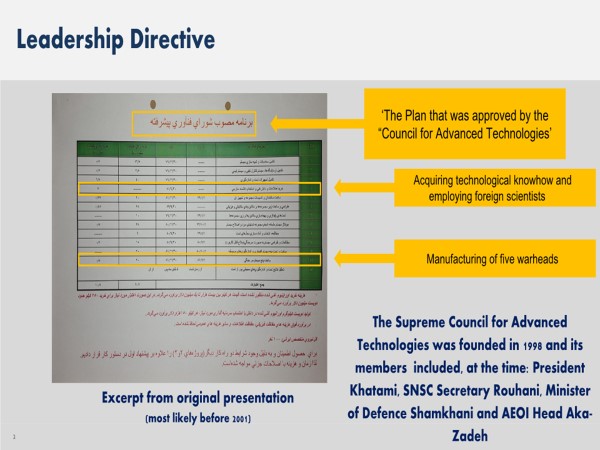
Figure 2. Slide from Netanyahu’s presentation, April 30, 2018, showing a partially translated Iranian table from the archive (see also Figure 4).
- Expenses related to acquisition of enriched uranium are not included. The price for 1 kg has been estimated between 20,000 and 1 million Dollars. If so, the required allocation for the purchase of 250 kgs is about 200 million Dollars.
- Production of 200 kg enriched Uranium inside Iran is estimated as about 150,000 Dollars per kg, given the required budget
- This estimate does not take into account physical security expenses, information security and other such general expenses.
- Total number of Iranian personnel: 100 people. [Authors’ comment: the number of people involved directly in the program increased substantially above this number in subsequent years.]
- For assurances, and in light of existing conditions, two additional strategies have been added to the agenda alongside the initial proposition (projects 2 and 3). Therefore, minor changes in time and expenses are expected.
The Plan Approved by the Advanced Technologies Committee
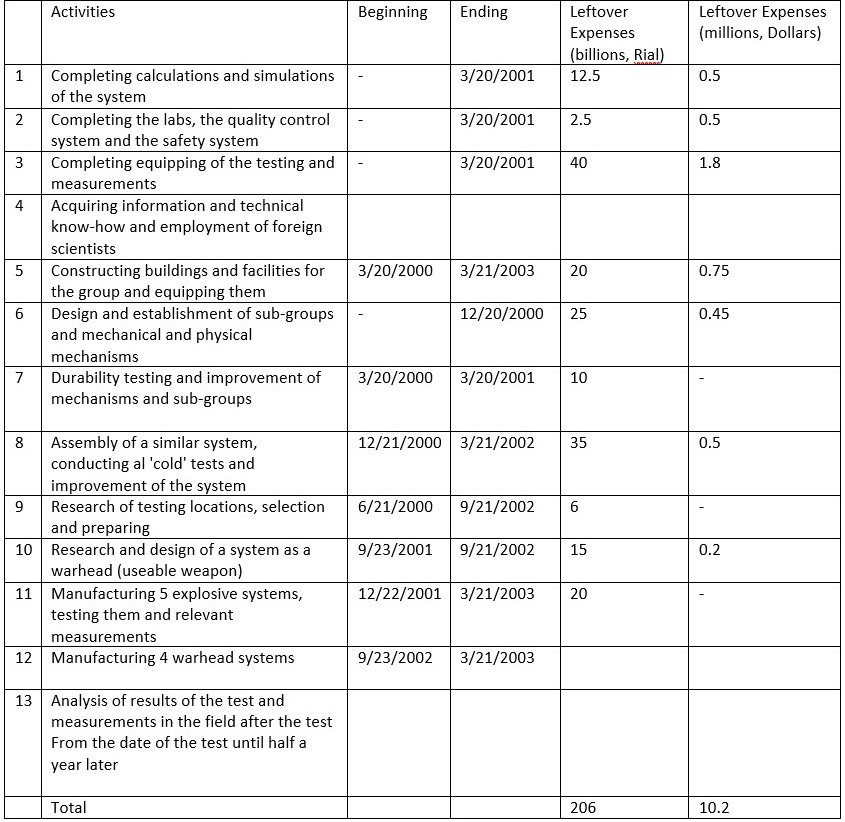
Figure 3. Plan Approved by the Advanced Technologies Committee (English translation of Farsi table (see Figure 4)).
As is typical of many documents in the archives or in the possession of the IAEA, the writers avoided being too explicit, omitting direct discussion of nuclear weapons and using code words. This practice has been common in secret nuclear weapons programs since the U.S. Manhattan Project during World War II. The United States, for example, referred to plutonium as “the product.” In the Iranian document, deliverable nuclear weapons appear to be referred to as “warhead systems,” and basic nuclear devices as “explosive systems.” Weapon-grade uranium or highly enriched uranium appears to be referred to as “enriched uranium.”
The plan entails an ambitious timetable of accomplishing a set of 13 tasks, culminating in readiness for a nuclear test as early as 2002 or 2003. The plan envisioned manufacturing “5 explosive systems” by early 2003. Their specific manufacture and testing were projected to occur from December 2001 to March 2003, or at a rate of about one explosive system every three months. The plan also called for the overlapping manufacture of four warhead systems in six months, from September 2002 until March 2003. The exact timing of an underground test is not given in the table, suggesting that Iran had not yet decided whether or when to conduct a test. However, the timetable and other information from the archive support that the regime had every intention to conduct one and was seeking an acceptable test site.4 The timetable was not achieved as planned, although by 2003, Iran was undertaking extensive work on the tasks outlined in this earlier plan. By the time the nuclear weapons program was re-oriented in 2003 and 2004, Iran had not built any nuclear weapons.
As mentioned above, the plan does not list the tasks or a timetable to obtain highly enriched uranium, which is the essential nuclear fuel for Iranian nuclear weapons. However, in a footnote to the table, it is noted that the table not does not include expenses related to the acquisition of enriched uranium, which is likely the most enriched type of highly enriched uranium, namely weapon-grade uranium. Two cases of expected costs are presented in the footnote, what appears to be what it would cost to purchase weapon-grade uranium from abroad or to produce it in Iran. The former includes an estimate of acquiring one kilogram at a value estimated as between $20,000 and $1,000,000.5 “If so, the required allocation for the purchase of 250 kgs is about 200 million dollars.” Although Iran is believed to have sought fissile material in the early 1990s in the former Soviet Union, including at the Ulba Metallurgical Plant in Kazakhstan that had an inadequately protected inventory of hundreds of kilograms of highly enriched uranium, it is not believed to have acquired enough for a nuclear weapon.6 However, Iran may have been tricked into paying a considerable amount of money in a scam.7 The latter option—production inside Iran, lists a goal quantity of “200 kg of enriched uranium” produced at about $150,000 per kilogram, given the required budget. This totals to $30 million. Clearly, at these prices, domestic production would be preferred.
At roughly 20 kilograms of weapon-grade uranium per weapon, 200 kilograms is enough for at least ten nuclear weapons. This may represent a longer-term goal for the nuclear weapons program or the creation of a reserve of enriched uranium.
When the plan was approved, several of the tasks were already underway. These included (Figures 2 and 3):
- 1. Completing calculations and simulations of the “system,” which as discussed above appears to be the code word for a nuclear explosive;
- 2. Completing the laboratories, the quality control system and the safety system;
- 3. Completing equipping of the testing and measurements; and
- 4. Acquiring information and technical know-how and employment of foreign scientists.
The first three tasks were expected to be completed in early 2001 and involved both additional expenditures in Iranian rial and U.S. dollars. The latter appears to be expenses paid for in dollars, and not a conversion from rial to dollars. A question is whether these expenses could have been for purchasing equipment, material, or other goods from abroad, which would have required U.S. dollars. For example, task three explicitly involves obtaining equipment, and its U.S. dollar budget is almost double that of the dollar budget of the first two tasks ($1.8 vs. $1.0 million).
The last of these four tasks, namely acquiring technology and employing foreign scientists, is missing a budget. Vyacheslav Danilenko is thought to be one of the experts employed by the nuclear weapons program starting in the mid-to-late 1990s and ending in about 2002.8 The use of the plural in this table implies that either there were others aiding Iran or it intended to recruit other foreign experts. The omission of a projected expense amount may also suggest that this aspect of the effort was being paid from another budget.
Most of the tasks had not started at the time of the approval of this plan. The remaining nine tasks were:
- 5. Constructing buildings and facilities for the group and equipping them;
- 6. Design and establishment of sub-groups and mechanical and physical mechanisms;
- 7. Durability testing and improvement of mechanisms and sub-groups;
- 8. Assembly of a similar system, conducting “cold” tests and improvement of the system;
- 9. Research of testing locations, selection and preparing;
- 10. Research and design of a system as a warhead (usable weapon);
- 11. Manufacturing 5 explosive systems, testing them and relevant measurements;
- 12. Manufacturing 4 warhead systems; and
- 13. Analysis of results of the test and measurements in the field after the test.
Many of the tasks had overlapping schedules. A considerable amount of the funds was slated for building facilities, equipping them, and undertaking testing. This type of testing would involve subsystems of the nuclear weapon, such as what occurred at the Parchin high explosive test site, at a site near Marivan, or other sites listed in the archives involved in equation of state experiments, high explosive manufacturing, and additional aspects of researching, developing, and manufacturing nuclear weapons. The manufacturing of five explosive systems, of which four would be “warhead systems,” required almost a fifth of the listed budget. The expected costs for an underground nuclear test are not included and may have been included in another budget.
There is no doubt that this weaponization plan, particularly its timeframe, was overly ambitious, perhaps stimulated by foreign assistance. Nonetheless, later documents and photos show that by 2003 Iran had made considerable progress in putting together a complex to design, develop, test, and manufacture deliverable nuclear weapons, when the program stalled in mid-2003 following the U.S. invasion of Iraq and intrusive IAEA inspections uncovering a wide range of Iran’s deception and violations related to undeclared fuel cycle activities.
The tasks in this early table track with more formal projects listed in later documents, when the program was further along in terms of planning and implementation. In the later documents, these subprojects are explicitly under Project 110, which was under the AMAD program. These later tables give a start date of Project 110 of March 20, 2000. This start date is consistent with the table discussed in this report.
Findings and Recommendations
There are several findings associated with this first look at Iran’s nuclear weapons plans.
These initial Iranian plans show that Iran was achieving much more than feasibility and scientific studies, as the IAEA assessed in late 2015.9 It is significant that by the late 1990s, Iran had made the decision to put in place the infrastructure and knowledge to manufacture within a relatively short period of time five nuclear weapons. It went far in establishing the infrastructure for a comprehensive nuclear weapons program with a full range of technical competences and capabilities, not just some, as characterized by the IAEA in late 2015.10 It should be noted that in late 2015, the IAEA had less information available to it, so its cautious statements are understandable. However, it also must be acknowledged that at that time, the IAEA, and the JCPOA parties, appeared to be downplaying the Iranian nuclear weapons program so as not to stand in the way of starting the implementation of the JCPOA in January 2016. Today, the IAEA has in its possession much of the content from the Iranian archive; it should be expected to act on this information, something that is not yet visible, after six months of examining the new information.
The infrastructure Iran was planning in this initial plan would have allowed for the production of more than five nuclear weapons. As such, the goal of producing five nuclear weapons should be viewed as an initial one, and these would mainly serve as a deterrent when noting also the fairly low yield planned.
By its actions, Iran showed a complete disregard and contempt regarding its obligations under the Nuclear Non-Proliferation Treaty (NPT), its comprehensive safeguards agreement with the IAEA, its signing of the Comprehensive Test Ban Treaty (CTBT), and other countries’ export controls. Its on-going refusal to admit to having a nuclear weapons program or allow the IAEA to carry out its mandate to verify compliance with the NPT and its comprehensive safeguards agreement and Additional Protocol must be viewed as an affront and challenge to the entire structure of nuclear non-proliferation agreements and norms.
The ability to make highly enriched uranium, which is only briefly discussed in this table, would evolve into a critical bottleneck in Iran’s nuclear weapons effort by 2003. But the skill of the Iranians in negotiating is apparent in that, under Rouhani’s leadership, Iran managed during the height of the crisis with the international community in 2003 and 2004, to preserve its gas centrifuge enrichment program and achieve an eventual form of international acceptance for that program to continue, as long as it was under IAEA safeguards. Yet, bringing that full enrichment program under international inspections did not happen for several more years, as witnessed by Iran’s misleading inspectors about its advanced centrifuge program and subsequently building in secret the Fordow enrichment plant originally designed to make weapon-grade uranium.
The nuclear weapons program, as implemented under this early plan and later AMAD programs, was too big and valuable to halt. Iran had invested far too many resources into it and still faced the same threat from the United States and its allies. Not surprisingly, the leadership focused on its preservation and continuation, while better camouflaging its activities as civilian in nature.11
An extensive amount of equipment, material, software, and other information needed to be preserved and stored by Iran, while allowing progress to be made. Israel’s recent discovery of a warehouse in the Turquz Abad neighborhood of Tehran, allegedly holding at least some of this equipment and material, reinforces that the program’s remains, and likely some activities, may have continued up to today.
Mr. Rouhani was a central, on-going figure in the nuclear weapons program in the late 1990s and early 2000s. It is difficult to find evidence that his support for nuclear weapons ever ended. If anything, he seems to offer continuity for finding ways to deflect international pressure while continuing the program, awaiting a day when Iran can decide whether the program should fully re-emerge and build nuclear weapons.
Currently, the onus has been on Israel to discover and characterize Iran’s past and possibly on-going, secret nuclear weapons efforts. Moreover, many have resisted acting on this information. This is inconsistent with the intent of Iran’s comprehensive safeguards agreement, the Additional Protocol, and the JCPOA. When material violations of these agreements are alleged, backed up by concrete evidence, the natural responsibility is to act, demanding that Iran answer these allegations and allow IAEA inspections. Given the weight of the evidence, it is Iran’s responsibility to disprove all this evidence of its past and possibly on-going deception.
The information in the archives shows that Iran is susceptible to international pressure and that it feared military strikes or a confrontation enough to re-orient and hide some of its most damning activities. The JCPOA only helped limit Iran’s enrichment and plutonium programs, creating a temporary bottleneck that will eventually end. Once it does, Iran will still maintain all the infrastructure and expertise to build nuclear weapons at a later date. The current U.S. strategy to ramp up pressure through sanctions is therefore probably the best way to prevent Iran from building nuclear weapons and negotiate a more comprehensive nuclear agreement, which must also include ballistic and cruise missiles, a need demonstrated by the past existence of Project 111, which focused on the missile re-entry vehicle for a nuclear weapon.
It would be helpful to be able to assess that Israel’s seizure of a significant portion of the Iranian nuclear archive damaged the ability of Iran to reconstitute its nuclear weapons program, such as if the documents and images Israel seized were unique and the only forms in Iran’s collection. However, according to senior Israeli officials, Israel was not able to take most of the documents in the archive, and there could be other unknown archives and working documents in Iran. Nonetheless, the seizure likely disrupted the program and generated a great deal of new information, that if properly used, can significantly increase pressure on Iran.
The question of where all this equipment, remaining documents, and material is now located is more urgent to answer. There is no evidence that Iran systematically destroyed these items. While Iran razed buildings, such as at the Physics Research Center, and emptied out others, such as the Parchin high explosive testing site, it preserved their equipment, documentation, and materials.
It is important to note that in both the case of the Nuclear Archive and warehouse in Turquz Abad, Israel publicly revealed these findings only after briefing the IAEA and it failed to act. Visiting the warehouse that allegedly held these items and insisting that Iran produce the shipping containers removed from the site and their contents is even more important. The IAEA should request, if not already done, that Iran explain their whereabouts and not move or destroy any of these materials before the IAEA has been able to examine them.
The IAEA’s unwillingness to ask to inspect the warehouse site and its slow response to acting on the information in the archives after being secretly briefed about their existence and purpose from Israel raises questions about the IAEA’s impartiality and ability to verify both the JCPOA and Iran’s nonproliferation commitments. It is not only the Secretariat, but the IAEA Board of Governors, which has not lived up to its task. They have created a double nonproliferation standard which, unless remedied, will decrease the chance of ensuring Iran does not build nuclear weapons and will serve as a playbook for future proliferators.
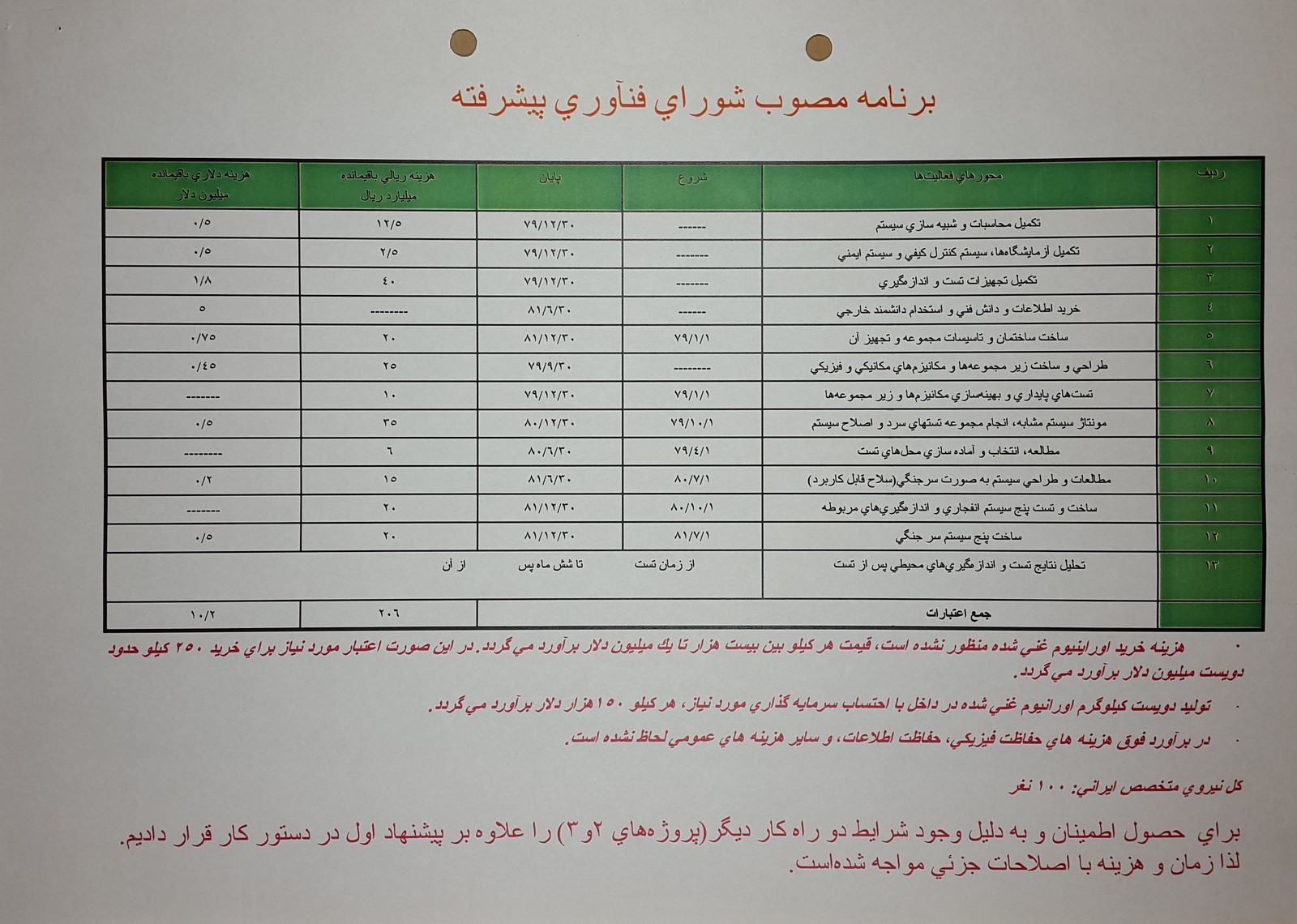
Figure 4. Original table from Figure 3 in Farsi.
* Olli Heinonen is former Deputy Director General of the IAEA and Head of its Department of Safeguards. He is a Senior Advisor on Science and Nonproliferation at the Foundation for Defense of Democracies.
2. Prime Minister Benjamin Netanyahu, Presentation, April 30, 2018, Available at: https://www.youtube.com/watch?v=qmSao-j7Xr4↩
3. Albright, Heinonen, and Stricker, “Breaking Up and Reorienting Iran’s Nuclear Weapons Program - Iran’s Nuclear Archive Shows the 2003 Restructuring of its Nuclear Weapons Program, then called the AMAD Program, into Covert and Overt Parts,” Institute for Science and International Security, October 29, 2018, http://isis-online.org/isis-reports/detail/breaking-up-and-reorienting-irans-nuclear-weapons-program; Albright, Sarah Burkhard, Heinonen, and Frank Pabian, “New Information about the Parchin Site: What the Atomic Archive Reveals About Iran’s Past Nuclear Weapons Related High Explosive Work at the Parchin High Explosive Test Site,” Institute for Science and International Security, October 23, 2018, http://isis-online.org/isis-reports/detail/new-information-about-the-parchin-site; “Iran’s Investigation of Possible Underground Nuclear Test Sites in the AMAD Program prior to 2004,” Institute for Science and International Security, May 1, 2018, http://isis-online.org/isis-reports/detail/irans-investigation-of-possible-underground-nuclear-test-sites-in-the-amad/8↩
4. See for example April 30, 2018 presentation by Prime Minister Netanyahu or the Institute report, “Iran’s Investigation of Possible Underground Nuclear Test Sites in the AMAD Program prior to 2004,” May 1, 2018, http://isis-online.org/isis-reports/detail/irans-investigation-of-possible-underground-nuclear-test-sites-in-the-amad/8↩
5. The spot separative work cost in the late 1990s was about $80 per SWU. For the production of one kilogram of low enriched uranium, a total of about five or six SWU are needed, for a cost of $400 to $480 using prices from the late 1990s. The cost of uranium and its conversion into uranium hexafluoride must also be considered, and these costs could increase the total cost by a factor of two to four. Including these additional costs brings the cost of one kilogram of low enriched uranium to less than $2000, far below the costs discussed in the table. For weapon-grade uranium, far more SWU are needed, say about 200 SWU per kilogram, which is about $16,000 per kilogram of weapon-grade uranium. Far more uranium is needed to make one kilogram of weapon-grade uranium than one kilogram of low enriched uranium, which increases the costs significantly. The cost range given in the table corresponds to weapon-grade uranium and not low enriched uranium. The extreme upper bound likely involves the anticipated extra costs of illicit procurement. It should be noted that the above calculation uses the spot separative work cost; the cost to produce separative work in Iran would be considerably more.↩
6. For a summary of Iranian attempts to acquire fissile material in the early and mid-1990s, see Albright, Frans Berkhout, and William Walker, Plutonium and Highly Enriched Uranium 1996 (Oxford: Oxford University Press, 1997), pp. 352-363 but in particular pp. 352 and 359.↩
7. Interview by Albright of senior U.S. intelligence official, 1995.↩
8. IAEA Director General, Implementation of the NPT Safeguards Agreement and relevant provisions of Security Council resolutions in the Islamic Republic of Iran Report, GOV/2011/65, November 8, 2011, https://isis-online.org/uploads/isis-reports/documents/IAEA_Iran_8Nov2011.pdf; and David Albright and Robert Avagyan, “Revisiting Danilenko and the Explosive Chamber at Parchin: A Review Based on Open Sources,” Institute for Science and International Security, September 17, 2012, http://isis-online.org/isis-reports/detail/revisiting-danilenko-and-the-explosive-chamber-at-parchin-a-review-based-on/↩
9. IAEA Director General, Final Assessment on Past and Present Outstanding Issues Regarding Iran’s Nuclear Programme, GOV/2015/68, December 2, 2015, http://isis-online.org/uploads/isis-reports/documents/IAEA_PMD_Assessment_2Dec2015.pdf↩
10. Ibid.↩
11. Albright, Heinonen, and Stricker, “Breaking Up and Reorienting Iran’s Nuclear Weapons Program.”↩

 twitter
twitter